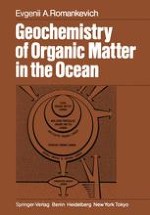1984 | OriginalPaper | Buchkapitel
Proteinaceous Compounds and Amino Acids
verfasst von : Dr. Evgenii A. Romankevich
Erschienen in: Geochemistry of Organic Matter in the Ocean
Verlag: Springer Berlin Heidelberg
Enthalten in: Professional Book Archive
Aktivieren Sie unsere intelligente Suche, um passende Fachinhalte oder Patente zu finden.
Wählen Sie Textabschnitte aus um mit Künstlicher Intelligenz passenden Patente zu finden. powered by
Markieren Sie Textabschnitte, um KI-gestützt weitere passende Inhalte zu finden. powered by
Most of the data on the total content of proteins in the plankton and benthos was obtained by means of the Biuret and Lowry methods, or was calculated from the nitrogen content (N×6.25, e.g., Parsons et al. 1961, Vinogradova 1967b, Raymont et al. 1971, Kizevetter 1973). Bogorov (1967) reviewed the data available from various publications on the content of the major classes of OM in marine organisms, and derived their mean values (Table 41). Using these N/C ratios, the estimated total content of nitrogenous compounds in OM of marine organisms is as follows: for diatom plankton — 38 – 71% (averaging 53%), peridinium — 25 – 59% (averaging 40%), plankton with a predominance of blue-green algae — 33 – 40% (averaging 36%), crustacean Zooplankton — 46 – 88% (averaging 72%), zoobenthos — 72 – 84%, bacteria — about 75%, phytobenthos — 7 – 36% (averaging 17%). Proteins constitute only 70 – 85% of the nitrogenous substances in marine organisms. These seem to be overestimates, although on the whole they correctly depict the total content of amino acids in marine organisms (Fig. 48).
